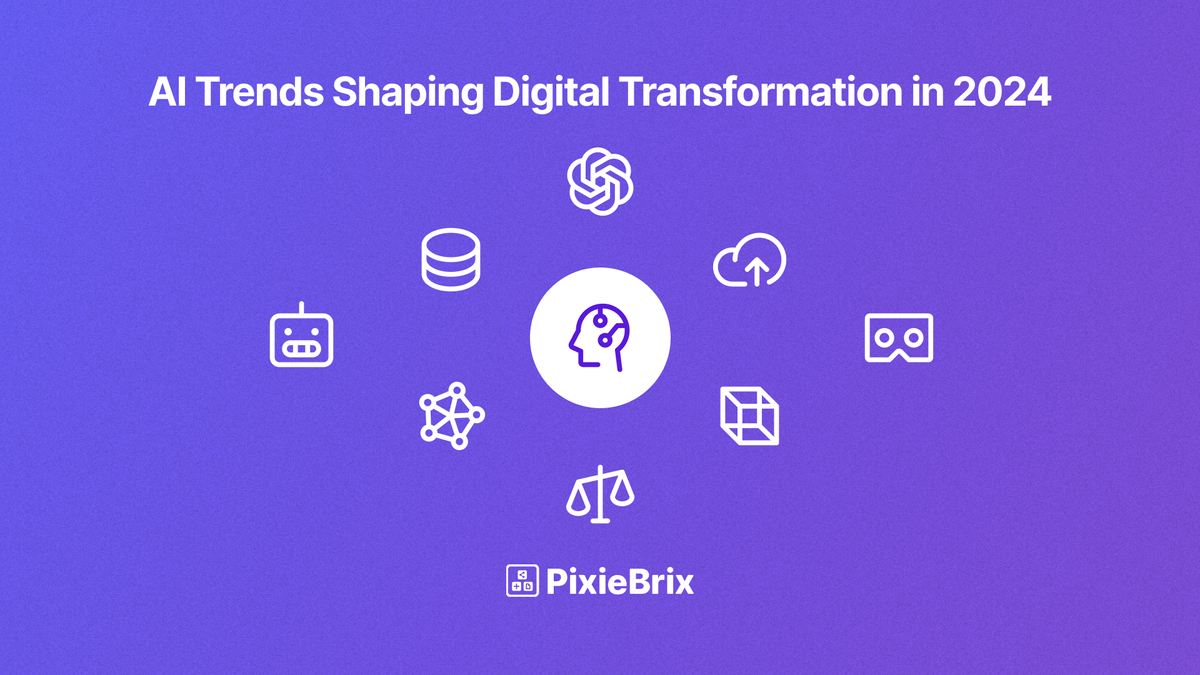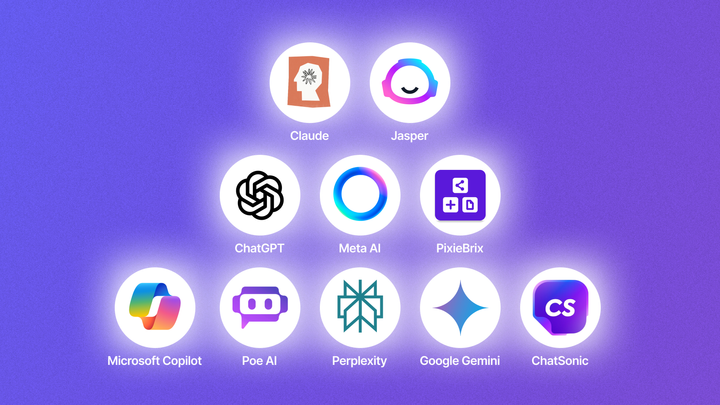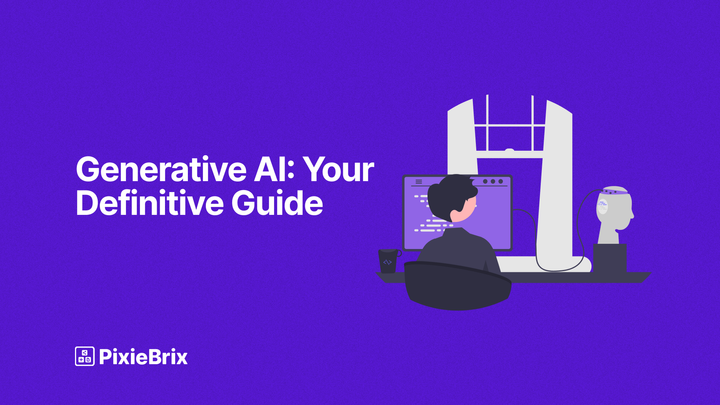Top Trends in AI for Digital Transformation in 2024

In 2024, digital transformation is no longer a buzzword, it's the key to staying competitive. Artificial intelligence (AI) is at the forefront of this revolution, and businesses are rapidly adopting new and innovative ways to leverage its power. From creating hyper-personalized experiences to automating complex tasks, AI is transforming every aspect of how companies operate.
Focus on Data Quality and Ethics
As AI becomes more powerful, the quality and ethical sourcing of data becomes even more critical. Businesses will be looking for tools to improve data accuracy, security, and ensure responsible AI development.
Data Quality: Enhancing Accuracy and Security
AI algorithms are only as effective as the data they are trained on. Therefore, ensuring data accuracy and integrity is foundational to leveraging AI for informed decision-making and operational efficiency. Businesses are investing in tools and technologies that enable robust data management practices, including data cleansing, validation, and integration. By enhancing data quality, organizations can unlock actionable insights and drive more reliable AI-driven solutions.
Ethical Sourcing and Responsible AI Development
The ethical implications of AI technologies are gaining prominence as businesses navigate complex regulatory landscapes and societal expectations. Ethical AI development requires careful consideration of biases, fairness, and transparency in algorithmic decision-making. Tools and frameworks that promote ethical sourcing of data and responsible AI deployment are essential for building trust with stakeholders and ensuring compliance with evolving regulations.
Tools and Solutions for Data-Driven Success
In 2024, businesses will seek advanced tools and solutions that support their AI initiatives while addressing data quality and ethical concerns. This includes:
- Data Governance Platforms: Enabling organizations to establish policies, procedures, and controls for data management and compliance.
- AI Ethics Toolkits: Providing frameworks and guidelines for ethical AI development, including bias detection, fairness assessments, and explainability features.
- Secure Data Sharing Technologies: Facilitating safe and compliant data sharing among stakeholders while protecting sensitive information.
Hyper-Automation Takes Hold
Hyper-automation, the integration of AI and robotic process automation (RPA), is poised to revolutionize industries in 2024. By combining these advanced technologies, businesses can streamline operations like never before. Experts forecast a substantial 30% reduction in operational expenses, showcasing the transformative potential of hyper-automation.
AI enhances hyper-automation by enabling intelligent decision-making and data processing, while RPA automates repetitive tasks with precision and efficiency. Together, they create a dynamic ecosystem where processes are optimized, workflows are streamlined, and productivity soars.
As organizations embrace hyper-automation, they unlock new possibilities for innovation and growth. It's not just about cutting costs; it's about leveraging AI and RPA to drive agility, enhance customer experiences, and empower employees to focus on high-value tasks. In 2024, hyper-automation isn't just a trend—it's a strategic imperative for businesses ready to thrive in the digital era.
The Rise of the Supercharged Virtual Agent
Virtual assistants have evolved far beyond their origins as simple tools for customer service inquiries. In 2024, we're witnessing the emergence of supercharged virtual agents capable of handling complex tasks and interactions with unprecedented efficiency and intelligence. These advanced virtual agents leverage multimodal AI technologies to access and synthesize information from diverse sources, enabling them to not only respond to queries but also to proactively assist and complete tasks on behalf of users.
Multimodal AI: Unlocking New Capabilities
Multimodal AI represents a significant leap forward in virtual agent capabilities. By integrating multiple modes of communication—such as text, speech, images, and even gestures—these agents can comprehend and respond to human inputs in more natural and contextually relevant ways. This capability enhances their ability to understand complex requests, interpret nuanced information, and deliver personalized responses that mimic human-like interaction.
Handling Complex Requests and Tasks
In 2024, supercharged virtual agents are equipped to handle a wide range of complex requests that go beyond basic customer service inquiries:
- Information Retrieval: They can access and retrieve information from extensive databases, knowledge bases, and real-time sources.
- Task Automation: Virtual agents can automate routine tasks such as scheduling appointments, booking reservations, or even conducting preliminary research on behalf of users.
- Decision Support: Using advanced algorithms, they can analyze data, provide recommendations, and support decision-making processes across various domains.
The Age of Hybrid Cloud AI
Many businesses are adopting a hybrid cloud approach to AI, leveraging the scalability of cloud services with the security and control of on-premises infrastructure. This strategic integration allows organizations to harness the power of AI while navigating complex data privacy regulations and ensuring sensitive information remains secure.
The hybrid cloud AI model enables businesses to scale AI initiatives more efficiently, leveraging cloud resources for computational power and storage, while maintaining critical data and applications on-premises for enhanced control and compliance. This approach not only accelerates innovation by enabling faster deployment of AI applications but also optimizes cost efficiency by dynamically scaling resources based on workload demands.
As businesses continue to prioritize data security and regulatory compliance, the hybrid cloud AI strategy emerges as a pivotal solution, offering the best of both worlds in terms of scalability, agility, and control. By embracing hybrid cloud AI, organizations are poised to drive significant advancements in AI-driven insights, customer experiences, and operational efficiencies in 2024 and beyond.
Generative AI's Second Act
As we delve deeper into 2024, the landscape of artificial intelligence (AI) is undergoing a profound shift with the rise of Generative AI (GenAI). According to Gartner's forecast, by this year, approximately 30% of companies are expected to integrate Generative AI into their operations. This marks a pivotal moment in AI evolution, where Generative AI transcends traditional applications to autonomously create new and diverse content forms, including code, text, and images.
Generative AI represents a significant leap forward from conventional AI tools, which primarily focused on automating repetitive tasks and data analysis. With its ability to generate complex and original content, GenAI unlocks new possibilities across industries, redefining how businesses approach creativity, innovation, and efficiency.
The Impact of Generative AI Across Industries
1. Innovating Content Creation: Generative AI empowers businesses to automate and accelerate content creation processes. From generating marketing copy and blog articles to designing visual content and crafting code snippets, GenAI streamlines workflows and enhances productivity.
2. Advancing Personalization: By analyzing vast datasets and user behaviors, Generative AI enables hyper-personalized customer experiences. It tailors content and recommendations based on individual preferences, driving engagement and customer satisfaction.
3. Transforming Creative Industries: In sectors like media, entertainment, and design, Generative AI sparks creativity by generating novel ideas, artistic expressions, and interactive experiences. It collaborates with human creators to push boundaries and innovate storytelling.
4. Revolutionizing Development and Engineering: GenAI accelerates software development cycles by autonomously writing code, debugging applications, and optimizing algorithms. It augments engineers' capabilities, enabling rapid prototyping and iterative improvements.
Digital Humans and Digital Twins
The landscape of digital transformation is evolving rapidly with the emergence of two groundbreaking AI innovations: digital humans and digital twins. These technologies are reshaping how businesses interact with customers, optimize operations, and drive innovation.
Digital Humans
Imagine a customer service representative who is always available, infinitely patient, and capable of handling complex inquiries with a human touch. Digital humans are AI-powered avatars that simulate human interaction through natural language processing (NLP) and facial recognition technologies. They are revolutionizing customer service by offering personalized assistance, troubleshooting support, and product recommendations in real-time. Beyond customer service, digital humans are becoming integral to training programs, providing immersive learning experiences that adapt to individual needs and preferences. In marketing, they serve as brand ambassadors, delivering engaging content and driving customer engagement through interactive storytelling.
Digital Twins
On the operational front, digital twins are virtual replicas of physical systems, processes, or assets that mirror their real-world counterparts in real-time. By leveraging IoT sensors, data analytics, and AI algorithms, digital twins capture and simulate the behavior, performance, and operational conditions of physical assets. This enables businesses to predict and prevent potential issues, optimize performance, and improve decision-making. In manufacturing, digital twins facilitate predictive maintenance by monitoring equipment health and performance metrics, minimizing downtime and reducing maintenance costs. In urban planning and infrastructure management, digital twins model cities and buildings to optimize energy consumption, enhance sustainability, and simulate scenarios for better disaster preparedness.
Why These Trends Matter
The adoption of digital humans and digital twins represents a paradigm shift in how businesses harness AI to enhance customer experiences, optimize operations, and drive innovation. By integrating these technologies into their digital transformation strategies, organizations can achieve greater efficiency, agility, and resilience in a rapidly changing market landscape.
Hyper-Personalization at Scale
Hyper-personalization stands out as a pivotal trend in digital transformation, powered by advanced AI capabilities. Businesses are leveraging AI to meticulously analyze vast troves of customer data, enabling them to craft highly personalized experiences at an unprecedented scale. This transformative use of AI empowers organizations to move beyond traditional segmentation approaches, reaching customers on a deeply individual level.
By harnessing AI-driven insights, businesses can understand and anticipate customer behaviors, preferences, and needs in real time. This enables them to deliver targeted content, recommendations, and offers that resonate with each customer's unique interests and motivations. Whether through personalized product suggestions, tailored marketing messages, or customized service interactions, AI-driven hyper-personalization fosters stronger customer relationships and enhances overall satisfaction.
This trend not only boosts customer engagement but also drives significant business outcomes, including increased conversion rates, higher customer retention, and enhanced brand loyalty. As AI continues to evolve, its ability to deliver hyper-personalized experiences will remain a cornerstone of digital transformation strategies in 2024 and beyond, shaping the future of customer-centric innovation across industries.
Explainable AI (XAI) Powers Transparency
With AI increasingly integrated into decision-making processes, there's a growing demand for transparency and accountability in AI models. XAI techniques help businesses understand how AI arrives at conclusions, improving trust, compliance with regulations, and facilitating better decision-making.
Why Explainable AI Matters
In many AI applications, especially in critical domains like healthcare, finance, and legal sectors, understanding why and how AI systems make specific decisions is paramount. Explainable AI addresses this by providing insights into the underlying logic, data, and factors influencing AI outputs. This transparency not only enhances trust but also facilitates compliance with regulatory requirements and ethical standards.
Techniques and Approaches
Explainable AI employs various techniques to achieve transparency in AI decision-making:
- Interpretable Models: Preference for using simpler and more interpretable machine learning models such as decision trees or linear regression, which allow stakeholders to understand how inputs are transformed into outputs.
- Model-Agnostic Methods: Techniques like LIME (Local Interpretable Model-agnostic Explanations) or SHAP (Shapley Additive Explanations) provide post-hoc explanations for complex models like deep neural networks, highlighting which features were most influential in a specific prediction.
- Visualizations and Dashboards: Tools that visualize model outputs, feature importance, and decision pathways help stakeholders grasp AI decisions intuitively.
AI-Powered Automation Streamlining Operations and Enhancing Efficiency
AI-powered automation stands at the forefront of digital transformation, revolutionizing how businesses streamline operations and boost efficiency. Organizations across industries are increasingly adopting AI-driven automation to tackle mundane tasks, optimize workflows, and free up valuable human resources for more strategic endeavors.
Robotic Process Automation (RPA)
Robotic Process Automation continues to lead the charge in automating repetitive tasks traditionally performed by humans. AI-powered bots are adept at handling data entry, processing transactions, and executing rule-based processes with unparalleled speed and accuracy. This not only accelerates operational timelines but also minimizes errors, resulting in enhanced reliability and cost savings.
Cognitive Automation
Cognitive automation takes automation a step further by integrating AI technologies such as machine learning and natural language processing (NLP). These capabilities enable systems to learn from data, make decisions, and interact with users in a more human-like manner. Cognitive automation is transforming customer service through AI-driven chatbots that understand and respond to customer inquiries with contextual relevance and empathy.
AI-Driven Decision-Making Processes
AI's ability to analyze vast datasets and derive actionable insights is reshaping decision-making processes within organizations. Machine learning algorithms predict outcomes, identify trends, and recommend optimal courses of action based on historical data and real-time inputs. This empowers business leaders to make informed decisions swiftly, driving agility and competitiveness in dynamic market environments.
Workflow Optimization
AI-powered automation optimizes complex workflows by identifying bottlenecks, streamlining processes, and allocating resources efficiently. Advanced analytics and predictive modeling anticipate operational needs, enabling proactive adjustments that enhance productivity and responsiveness. Organizations leveraging AI in workflow optimization experience reduced cycle times and improved service delivery, ultimately elevating customer satisfaction.
Edge AI Making Decisions in Real Time
Edge AI is emerging as a pivotal trend in digital transformation, revolutionizing how data is processed and utilized in real-time at the edge of networks. By deploying AI algorithms directly on devices and sensors, organizations can significantly reduce latency and bandwidth usage while enhancing decision-making capabilities locally. This approach not only improves efficiency but also enables autonomous operations in environments where immediate responses are critical, such as manufacturing floors, autonomous vehicles, and IoT ecosystems. Edge AI empowers devices to perform complex computations independently, leading to faster insights, enhanced security, and more resilient systems capable of operating offline or with intermittent connectivity. As businesses increasingly prioritize agility and responsiveness, edge AI is poised to play a pivotal role in driving innovation and transforming industry landscapes in 2024 and beyond.
Decentralized AI Advancements
Federated learning revolutionizes how organizations handle sensitive data while advancing machine learning capabilities. Unlike traditional centralized models, federated learning distributes model training across decentralized devices or servers, allowing data to remain locally stored. This decentralized approach not only preserves data privacy but also enhances scalability and accelerates learning.
Federated learning is particularly impactful in industries requiring sensitive data handling, such as healthcare and finance. It facilitates collaborative model training across multiple institutions or devices without sharing raw data, thus mitigating privacy risks. As organizations embrace federated learning, they can achieve significant advancements in AI capabilities, including improved model accuracy, faster training times, and enhanced adaptability to diverse data sources.
Moreover, federated learning supports edge computing initiatives by enabling AI model deployment directly on edge devices. This capability enhances real-time decision-making and responsiveness, critical for applications in IoT and autonomous systems. By integrating federated learning into their digital transformation strategies, businesses can unlock new opportunities for innovation, collaboration, and competitive advantage in the AI-driven landscape of 2024 and beyond.



